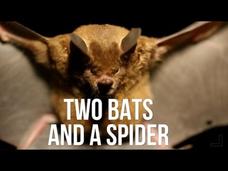Curated OER
Giant Honey Bees - Life in the Undergrowth
The biggest of all honey bees are shown in this video: the giant honey bee. A brave researcher reaches extremely tall heights to show viewers how the bees protect themselves.
Curated OER
Inside the Bee Hive
Take a daring dive into the depths of a bee hive to observe how these large colonies work together to gather pollen to produce honey. These bees are busy indeed and even have their own way of communicating. Check out this video to learn...
Curated OER
Parasitic Wasps
Check out this dramatic look at black wasps versus aphids! Naturally, these "aphid killers" are set to win the battle of survival. Watch this video to learn how these parasitic wasps kill their prey and plant their eggs! Note: This video...
Curated OER
Rhinoceros Beetle
The horn on a male rhinoceros beetle isn't just for show; they serve important purposes in the beetle's life. Watch this video to learn what those are!
Curated OER
Burying Beetles
"Ew, gross!" is a repeated phrase in this video and will most likely be the same for its viewers. It provides detailed information about the burying beetle and how they survive in the wild. Note: Some material in this video may be...
Curated OER
African Dung Beetle
Without dung beetles, well, there would be a lot more dung lying around. These beetles work together to gather and build dung balls. Watch this video to learn why! Their strength is really quite impressive.
Curated OER
Monarch Butterflies
Monarch butterflies are as fragile as they look and a small change of their environment could have a huge impact on their lives. Watch this video to learn about one instance where over 250 million monarch butterflies died.
Curated OER
Killer Bees
Learn about the killer bees in Central America's rainforests in this fantastic video. It discusses why these native honey bees are in danger and why it is important to keep them safe!
Curated OER
Life Cycle of a Dragonfly
Did you know that dragonflies don't go through complete metamorphosis, but rather a series of nymph stages? View this video to find out what life is like for a dragonfly from egg to adult! You'll learn all you need to know. A good video...
Be Smart
Attack of the Zombie Parasites!
There is a law in Haiti that makes it a crime to turn someone into a zombie. But is such a thing even possible? Scholars see examples of zombie-like organisms found here on Earth with a video that explores numerous examples, from the...
Be Smart
Why Do More Species Live Near the Equator?
The tropics contain about 40 percent of the area on Earth. Viewers take a trip to Peru as an entrancing video from a larger biology playlist explores the region. It explains the facts and theories about the biodiversity near the equator....
Curated OER
Life Cycle of a Flowering Plant
The development of the male and female gametes in a plant is illustrated, explaining plant fertilization, pollination, and reproduction. Overall, get a complete picture of the life cycle of a flowering plant with some wonderful details...
The Brain Scoop
In Search of Fossil Fish
Fossil Lake, Wyoming contains the most complete representation of early Eocene life in the world. The first of three videos on location at Fossil Lake discusses the process of finding fossils. It introduces the tools and methods used to...
The Brain Scoop
Two Bats and a Spider
What creatures lurk in the rainforest at night? Meet three of them in one short video. Part of a playlist exploring mammals, the video presents a look at night research in the Amazon. Scientists locate and photograph two bat species and...
Crash Course
Great Glands - Your Endocrine System
Diabetes is the most common endocrine disorder in the United States, affecting about eight percent of the total population. The working parts of the endocrine system are examined in a video that demonstrates how cells receive information...
SciShow
Robots Inspired By Animals
What would you name a swimming humanoid robot? Scientists went with the swumanoid. Video focuses on how scientists use animals and nature for inspiration in designing robots. It covers jumping, camouflage, flying, and more. These...
SciShow
Circadian Rhythm and Your Brain's Clock
Your class will not drift off to sleep during this episode on circadian rhythms. Though the narrator speaks quickly and continuously, he successfully explains our biological clock in a way that holds interest. Assign the viewing of this...
TED-Ed
Do We Really Need Pesticides?
How do we balance feeding an increasing population and using pesticides? Decide for yourself if the use of pesticides is necessary to keep up with the growing demand for food supply.
Be Smart
How Bees Can See the Invisible
What do bees use to get rid of tangles? A honey-comb! The video focuses on how bees instinctively find flowers — their eyes view the world differently than ours. They also seem to be guided by electric charges because the bees have a...
MinuteEarth
Invasion of the Yellow Crazy Ants!
How much does an invasive species really matter? The video focuses on examples of accidental species spread as well as intentional introductions. It highlights the problems caused by spreading new plants and animals to areas with no...
The Brain Scoop
Into the Bat Caves of Kenya: Part 2
Field research is dirty work! Join a team of research scientists from the Field Museum in the second installment of a two-part series that is part of a larger playlist exploring mammals. The team continues their search for bats in...
Curated OER
African Beetles Beat the Heat in the Sahara Desert
Three thousand plant species light up Africa's Karoo Desert for merely two weeks of the year. Compare and contrast the Karoo geography with that of the Sahara to highlight the difference just a few extra centimeters of rain can have on a...
ABCMouse
Big Bug and Little Bug
Impart the value of kindness and reinforce rhyming CVC words with a short video about a bug who offers help to another bug in need.
Other popular searches
- K 2 Life Science Insects
- Science Insects
- Parts of Insects Science
- Life Science Insects
- Science Spiders vs Insects
- Esl Lessons Science Insects
- Esl Science Insects
























